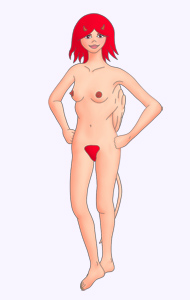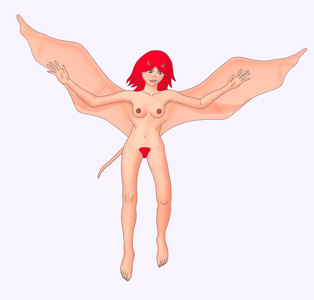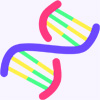 159k
159k
 213k
213k
Species name: Infernumhomo busani
Winged caudal humanoid. They have large leathery wings that can lift them and small payloads for several hours of flight.
They have a pair of short horns on their foreheads that their ancestors used for defense. Their ears are quite small due to the much higher density of their atmosphere. They have opposable thumbs. Feet and hands have five digits. Finger and toe nails are a bit thicker than a human's.
Gender differences:
Females have two breasts they to nurse their young. Their breasts only enlarge during lactation. Otherwise, they are the equivalent to an A or B cup size.
They are a crepuscular species, active in the permanent twilight of their world. Due to the nature of their environment, they never experience true day or night. Their visual acuity is about 20/30.
Their eyes about 15% larger than human. Pupils contract into vertical slits flanked by red irises.
They can see light from near green to near inferred (460 - 950 nm). Unlike most humans, they are dichromates. They can distinguish fewer shades of color than typical humans. Their two primary colors are Green: 580nm and Red: 715nm. The didn'e evolve to see blue since it is mostly absent in their environment.
Busani color response plot is on the left, human response plot is on the right for comparison.
The following photos attempt to illustrate differences between their vision and humans'. Again, Busani photos are on the left, human photos are on the right. Note: I have 'white' balanced the Busani photos to better simulate how the scene would appear to them.
They have a relatively weak sense of smell compared to humans. Their hearing range is 12-14,000 Hz with much lower than human sensitivity. In their much denser atmosphere, however, then smell and hearing senses are similar in capability to humans'.
They are Omnivorous and can digest both plants and animals.
They give live birth to typically a single child. Sexual maturity occurs around 14 years of age. Females are continually fertile between puberty and roughly 45 years of age. Females do not have menstruation cycles.
They are relatively healthy, but limited tool making due to their environment greatly limits their medical abilities. Their natural life span is around 70 years, but average life span is close to 40.
They are strong flyers and depending on atmospheric density, can carry up to 25% of their body weight when in flight.
They can metabolize Earth food. They are not effected by Earth viruses or most microbiotic pathogens. Their microbiotic pathogens do not harm Earth life. (Pathogens are usually too specialized to harm other biosphere organism's, but some planets have been found to be incompatible).
Copyright © 2017-2018 by David White
This page last updated 24-Jan-2018